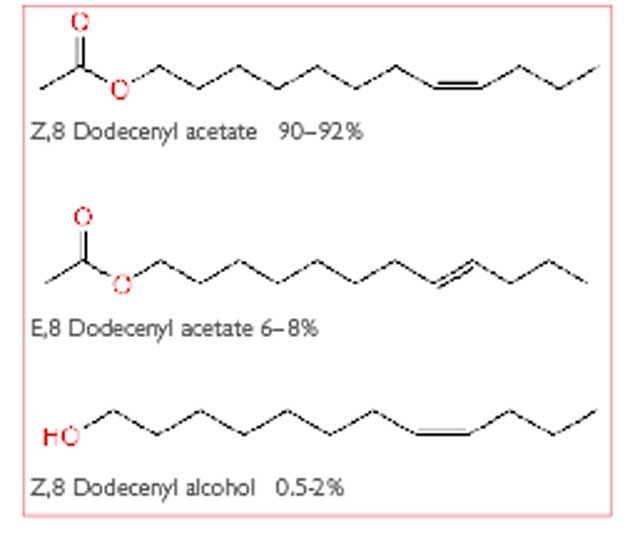What are pheromones?
Pheromones are natural volatile chemicals used by an organism to communicate with others of the same species.
Many different animals produce them but we know most about those used by insects. They fall into various categories:
•Sex pheromones are usually produced by females to attract males for mating but with some species, it is the other way around.
•Aggregation pheromones such as the ones produced by female Carpophilus beetles attract both males and females.
•Alarm pheromones are produced by aphids to warn others around them of danger—drop off the branch girls!
•Bees have a complicated portfolio of pheromones that regulate their complex society.
How pheromones are identified
Working out the identity of insect pheromones is not a trivial process.
It requires biologists working together with chemists, often for some years and with the use of some very sophisticated technology.
Take for example a moth pheromone. Biologists must breed the moths in the laboratory—not always easy—then see if virgin females will bring in males. If the answer is yes, then we know that a pheromone is operating.
The next step involves chemistry. The technology became available in the 1970s with the advent of new instruments called gas chromatogram/mass spectrometers (GCMS) costing hundreds of thousands of dollars.
Glands from the real end of virgin female moths are extracted and put into solvent and the extract is then run through the GCMS. A bunch of chemicals are revealed from the analysis and some might be the pheromone.
Initially this involved hundreds of moth rear ends but now it may require only one to get a tentative identification.
The next step is the make a few milligrams each of the candidate pheromone compounds in the chemistry lab. This may be a relatively simple procedure or it could take a PhD chemistry student a year to do it.
Having got this precious little sample, it is back to the biologists again.
It is now common to test the candidate compounds by measuring the electric signals from an excised male moth antenna using a setup called an electroantennagram.
A stream of pure air with a trace of the candidate compound in it is blown across the antenna stuck on the end of an electrode. If the cells on antenna detect the candidate compound, they give an electrical signal which is recorded.
A signal means that the compound might be the pheromone. If there is no signal, it is definitely not.
Most pheromones are a combination of related molecules. Oriental fruit moth pheromone (a typical moth pheromone) is a mixture of three compounds.
Samples of candidate pheromone are tested in wind tunnels and in traps in the field. If the candidate pheromone mixture is as good as a few virgin females then the pheromone is at least partly identified.
For the moth to recognize the pheromone it must be the right length (for OFM 12 carbons), must have the carbon-carbon double bond in the right position (position 8), and the blend of compounds with the right bends around the double bonds must be right.
Figure 1 shows thee three ingredients that together make up OFM pheromone
(cont. next month)
See this article in Tree Fruit July 2018




















